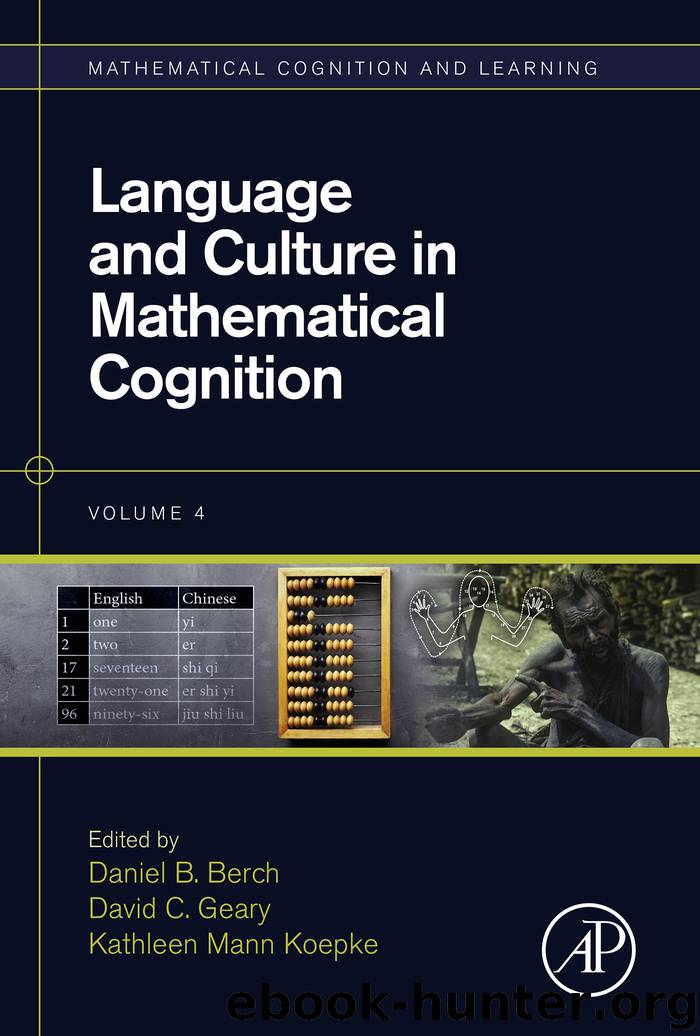Language and Culture in Mathematical Cognition by Daniel B. Berch David C. Geary Kathleen Mann Koepke & David C. Geary & Kathleen Mann Koepke

Author:Daniel B. Berch,David C. Geary,Kathleen Mann Koepke & David C. Geary & Kathleen Mann Koepke
Language: eng
Format: epub
ISBN: 9780128125755
Publisher: Elsevier Ltd.
Published: 2017-12-27T16:00:00+00:00
Fig. 1 Grand average ERPs from monolingual adults recorded in response to expected and unexpected sentence-final words (top, from Wicha, Moreno, & Kutas, 2004) and in response to correct and incorrect multiplication solutions presented as number words (middle) or Arabic digits (bottom) (unpublished data from Wicha lab). The data come from a representative electrode, with 1 s of time in milliseconds along the X-axis and voltage (in microvolts, with negative plotted up) on the Y-axis.
ERP studies of arithmetic have typically measured two effects: the congruency effect, primarily observed in verification tasks during recordings of the brain response to a provided answer (e.g., Niedeggen, Rosler, & Jost, 1999), and the problem-size effect, observed during recordings of the brain response either to provided answers or after presentation of the operands (e.g., 7 × 6) but prior to the answer itself (Jost, Hennighausen, & Rösler, 2004; Zhou et al., 2006). We focus here on the congruency effect, found in comparisons of brain responses for congruent solutions (correct answers) and incongruent solutions (incorrect answers), as this has been the primary effect measured in bilingual populations. Importantly, typical studies of the congruency effect report the time-locked brain response to the answer presented in isolation, after retrieval/calculation processes have already been initiated by prior presentation of the operands.
The congruency effect is characterized by a more negative response to incorrect solutions (e.g., 7 × 6 = 36) compared with correct solutions (e.g., 7 × 6 = 42), with a maximum peak amplitude difference occurring about 350–400 ms after the presentation of the answer (Niedeggen et al., 1999). This arithmetic congruency effect has drawn comparisons to similar effects in other domains that study the processing of potentially meaningful items (e.g., language and object processing). Notably, words that are unexpected/incongruent with a prior sentential context (e.g., the brain response to “dog” given the prior context, “he takes his coffee with cream and ___”) also elicit a more negative brain response than words that are expected/congruent with a prior context (e.g., the brain response to “sugar” given the same context), around 400 ms after the congruent/incongruent word is presented. Thus, the effect of answer congruency has been traditionally labeled an N400 effect (a negative-going wave sensitive to semantics/meaningfulness, peaking at 400 ms; see Kutas & Federmeier, 2011, for a review of N400 response properties).
Both the timing and the size of this congruency effect (i.e., the average difference in voltage across a time window surrounding the ERP effect) can be taken as independent measures of the brain's readiness to categorize an arithmetic problem as correct or not. If the maximal difference occurs later in time (i.e., at 400 ms instead of 350 ms), then it is reasonable to infer that the brain had to do additional processing before the correctness judgment could be fully rendered (much like an RT delay). Moreover, if the average voltage difference is a smaller or larger size in response to different contrasts of answer subtypes (e.g., table-related or table-unrelated incorrect solutions) or to the same answer subtypes under different contexts (e.
Download
This site does not store any files on its server. We only index and link to content provided by other sites. Please contact the content providers to delete copyright contents if any and email us, we'll remove relevant links or contents immediately.
The Art of Coaching Workbook by Elena Aguilar(50739)
Trainspotting by Irvine Welsh(21420)
Twilight of the Idols With the Antichrist and Ecce Homo by Friedrich Nietzsche(18443)
Fangirl by Rainbow Rowell(9009)
Periodization Training for Sports by Tudor Bompa(8091)
Change Your Questions, Change Your Life by Marilee Adams(7552)
This Is How You Lose Her by Junot Diaz(6694)
Asking the Right Questions: A Guide to Critical Thinking by M. Neil Browne & Stuart M. Keeley(5569)
Grit by Angela Duckworth(5442)
Red Sparrow by Jason Matthews(5317)
Paper Towns by Green John(5018)
Room 212 by Kate Stewart(4956)
Ken Follett - World without end by Ken Follett(4588)
Housekeeping by Marilynne Robinson(4246)
The Sports Rules Book by Human Kinetics(4207)
Papillon (English) by Henri Charrière(4138)
Double Down (Diary of a Wimpy Kid Book 11) by Jeff Kinney(4130)
The Motorcycle Diaries by Ernesto Che Guevara(3925)
Exercise Technique Manual for Resistance Training by National Strength & Conditioning Association(3900)
